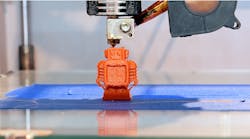You know when a product comes out and we think it's awesome? Then years later, something comes out to replace it, and we look back at the first thing like, "What a pile." Well, I'm almost to that point vis-à-vis 3D printers, even though there's nothing to replace them.
You're probably groaning by now, but hear me out. Yes, prices for the maker/desktop/DIY category of machines have dropped, the quality of their output has increased, and promotional materials abound with printers creating beautiful and delicate objets d'art.
But like the movie montage where the kids clean up the house before their parents get home, they are glossing over the details. What isn't shown is the effort, the sweat, the tinkering, the trial and error, and the screaming to the gods themselves to please, please let it work this time.
3D printers may be great, but do they really live up to the hype?
Let's address the obstacles that keep these devices from truly being the miracle that people have been gushing about for the last 15 years or so:
1. Warping
3D printers are extremely sensitive to temperature and temperature changes. Anyone who has any experience at all with them is familiar with this. This goes doubly so for users of unenclosed printers. If you don't know what I'm talking about, go start a print and then halfway through, swing the closest door wide open. Successful prints shouldn't be so sensitive.
2. Porosity
3D-printed parts are full of tiny holes. Even when you print with a 100% fill, it will leak. This prevents 3D-printed parts from being used in a vast range of applications.
3. Prints not sticking to the bed
Hairspray and masking tape are far from ideal solutions. Reapplying treatments or specialty surfaces is too much like inking the letters on a manual printing press. There is no equivalent operation necessary before you print out your great aunt's Bundt cake recipe on your inkjet. I don't think we should have to do that with our 3D printers, either.
4. Prints that won't come off the bed
The reverse of the previous issue is prints that won't unstick from the bed. We shouldn't have to push and pry on the print to the extent that it shakes the entire machine and misaligns the bed.
5. Prints that won't get out of the way for the next print
I want to set a queue and go do something else. Babysitting a printer is contrary to one of the supposed advantages of a 3D printer. We need some sort of changeover mechanism.
6. Printers are slow
For models of any substantial size, we're talking really slow. We get to wait hours or sometimes days to see if the print came out correctly.
7. Way too manual
We need 3D printers that are at the level of at least a black-and-white laser printer. You know—you just occasionally feed it paper and toner. Of course, 3D printers aren't even close to the same level of convenience and reliability. They're more like MP3 players that get songs loaded onto them via Morse code. Oh, and the Morse code tapper thing costs extra.
8. Software
A decent selection of software is available, and we've all seen the impressive results. The problem is that the software, if it's user accessible, requires a lot of tuning. Adjusting variables and trying to correlate cause with effect can be maddening. Sometimes it makes you feel like the Sisyphus of 3D printing: forever working toward a goal and never reaching it.
Read the full commentary—along with a list of some printers that do live up to the hype—at Machine Design, an NED partner.











